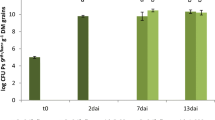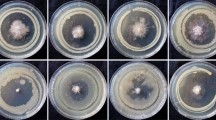Abstract
Fluorescent pseudomonads, which showed antagonism in vitro against Rhizoctonia solani and Pythium aphanidermatum, were investigated for antagonism in vivo using bean and cucumber. The efficiency of the antagonists in germination tests against Rhizoctonia solani was lower than against Pythium aphanidermatum. In soil infected with Rhizoctonia solani the germination rates of the seeds remained between 30 and 40%, whereas against Phytium aphanidermatum some Pseudomonas-strains caused germination rates of 40–60%. The preventive effect of the antagonists against fungal infection after the germination was better. 16 isolates reduced the damage caused by Rhizoctonia solani to bean between 90 and 100%. Damage caused by Pythium aphanidermatum to cucumber was reduced by 12 antagonists between 70 and 80%.
Zusammenfassung
Fluoreszierende Pseudomonaden, die sich als Antagonistenin vitro gegenüberRhizoctonia solani undPythium aphanidermatum erwiesen haben, wurden an Gurken und Bohnen auf Antagonismusin vivo untersucht. Die Effizienz der Antagonisten in Auflaufversuchen gegenüberR. solani war niedriger als beiP. aphanidermatum. Die besten Isolate konnten in mitR. solani verseuchter Erde Auflaufraten von 30–40% erzielen, gegenüberP. aphanidermatum dagegen 40–60%. Die Wirkung der Antagonisten zur Verhütung von Spätinfektionen der Pflanzen war deutlich besser. So konnten 16 Isolate eine Schädigung durchR. solani an Bohnen zwischen 90 und 100% reduzieren. An Gurken konnten 12 Isolate eine Schädigung durchP. aphanidermatum auf 70–80% reduzieren.
Similar content being viewed by others
Literatur
Adora, D. K.;Filnonow, A. B.;Lockwood, J. L., 1983: Bacterial chemotaxis to fungal propagulesin vitro and in soil. Can. J. Microbiol.29, 1104–1109.
Bandy, B. P.;Leach, S. S.;Tavantzis, S. M., 1988: Anastomosis group 3 is the major cause ofRhizoctonia disease of potato in Maine. Plant Dis.72, 596–598.
Bowen, G. D.;Rovira, A. C., 1976: Microbial colonization of plant roots. Ann. Rev. Phytopathol.14, 121–144.
Broadbent, P.;Baker, K. F.;Franks, N.;Holland, J., 1977: Effect ofBacillus spp. on increased growth of seedlings in steamed and nontreated soil. Phytopathol.67, 1027–1034.
Burr, T. J.;Schroth, M. N.;Sislow, T., 1978: Increased potato yields by treatment of seedpieces with specific strains ofPseudomonas fluorescens andP. putida. Phytopathol.68, 1377–1383.
Carling, D. E.;Leiner, R. H., 1990: Effect of temperature on virulence ofRhizoctonia solani and otherRhizoctonia on potato. Phytopathol.80, 930–934.
Carling, D. E.;Leiner, R. H.;Westphale, P. C., 1989: Symptoms, signs, and yield reduction associated withRhizoctonia disease of potato induced by tuberborne inculum ofRhizoctonia solani AG-3. Am. Potato J.66, 693–702.
Chao, W. L.;Nelson, E. B.;Hartmann, G. F.;Hoch, H. C., 1986: Colonization of the rhizosphere by biological control agents applied to seeds. Phytopathol.76, 60–65.
Cook, R. J.;Rovira, A. D., 1976: The role of bacteria in the biological control ofGaeumannomyces graminis by suppressive soils. Soil. Biol. Biochem.8, 269–273.
D'Ambra, V.;Mutto, S., 1986: Parasitism ofTrichoderma harzianum on cystosori ofPolymyxa betae. Phytopathol. Z.115, 61–71.
Davidson, F.;Reuszer, H. W., 1984: Persistence ofRhizobium japonicum on the soybean seed coat under controlled temperature and humidity. Appl. Environ. Microbiol.35, 94–96.
Elsherif, M., 1988: Auswirkungen unterschiedlicher Anbausysteme auf den Krankheitsbefall an Winterweizen und auf das Auftreten von Antagonisten, insbesondere von fluoreszierenden Pseudomonaden. Diss. Univ. Hohenheim.
Elsherif, M.;Grossmann, F., 1991: Versuche zur biologischen Bekämpfung einiger phytopathogener. Pilze durch fluoreszierende Pseudomonaden unter Anwendung verschiedener Applikationsverfahren. Z. f. Pflanzenk. und Pflanzenschutz98, 236–249.
Engelkes, C. A.;Windels, C. E., 1990: Pathogenicity of AG-2-2 cultures ofRhizoctonia solani isolated from beans and sugar beet on bean seedlings. Phytopathol.80, 970.
Howell, C. R.;Stipanovic, R. D., 1979: Control ofRhizoctonia solani on cotton seedlings withPseudomonas fluorescens and with an antibiotic produced by the bacterium. Phytopathol.69, 480–482.
Katznelson, H.;Peterson, E. A.;Rouatt, J. W., 1962: Phosphate dissolving microorganisms on seed and in the root zone of plants. Can. J. Bot.40, 1181–1186.
Kerr, A. 1967: The influence of soil moisture on infection of peas byPythium ultimum. Austr. J. Biol. Sci.17, 676–685.
King, E. O.;Ward, M. K.;Raney, D. E., 1984: Two simple media for the demonstration of pyocanin and fluorescin. J. Lab. Clin. Med.44, 301–307.
Kraft, J. M.;Erwin, D. C., 1967: Stimulation ofPythium aphanidermatum by exudates from mung bean seeds. Phytopathol.57, 866–868.
Laville, J.;Visard, C.;Keel, C.;Maurhofer, M.;Defago, G.;Haas, D., 1992: Global control inPseudomonas fluorescens mediating antibiotic synthesis and suppression of black rot of tobacco. Proc. Natl. Acad. Sci. USA89, 1562–1566.
Leben, C., 1983: Association ofPseudomonas syringae pv.lachrymans and other bacterial pathogens with roots. Phytopathol.70, 1078–1082.
Lewis, J. A.;Papavizas, G. C., 1980: Integrated control ofRhizoctonia solani fruit rot of cucumber. Phytopathol.70, 85–89.
Loper, J. E., 1986: Role of fluorescent siderophore production in biocontrol ofPythium ultimum byPseudomonas fluorescens strain 3551. Phytopathol.76, 1069.
McCarter, S. M.;Littrell, R. H., 1969: Comparative pathogenicity ofPythium aphanidermatum andPythium myriotylum to twelve plant species and intraspecific variation in virulence. Phytopathol.60, 264–268.
Merriman, P. R.;Price, R. D.;Kollmorgen, J. F.;Piggott, T.;Ridge, E. H., 1974: Effect of seed inoculation withBacillus subtilis andStreptomyces griseus on the growth of cereals and carrots. Aust. J. Agric. Res.25, 219–226.
Michael, A. H.;Nelson, P. E., 1972: Antagonistic effect of soil bacteria onFusarium roseum “Culmorum” from carnation. Phytopathol.62, 1052–1056.
Mitchell, D. J. 1978: Relationships of inoculum levels of several soilborne species ofPhytophtora andPythium to infection of several hosts. Phytopathol.68, 1754–1759.
Middleton, J. T., 1943: The taxonomy, host range, and geographic distribution of the genusPythium. Mem. Torrey Bot. Club20, 1–171.
Nair, N. G.;Fahy, P. C., 1976: Commercial application of biological control of mushroom bacterial blotch. Aust. J. Agric. Res.27, 415–422.
Papavizas, G. C., 1985:Trichoderma andGliocladium: Biology, ecology and potential for biocontrol. Ann. Rev. Phytopathol.23, 23–54.
Rouatt, J. W.;Peterson, E. A.;Katznelson, H.;Henderson, V. E., 1963: Microorganisms in the root zone in relation to temperature. Can. J. Microbiol.9, 227–236.
Sarbini, G.;Kommedahl, T., 1977 Effect of bacterial seed treatment on stand and yield of soybeans inPhytophtora-infested soil. Proc. Am. Phytopathol. Soc.4, 146.
Scher, F. M.;Kloepper, J. W.;Singleton, C. A.: 1985: Chemotaxis of fluorescentPseudomonas spp. to soybean seed exudatesin vitro and in soil. Can. J. Microbiol.31, 570–574.
Scher, F. M.;Kloepper, J. W.;Singleton, C.;Zaleska, I.;Laliberté, M.; 1988: Colonization of soybean roots byPseudomonas andSerratia species: relationship to bacterial motility, chemotaxis, and generation time. Phytopathol.78, 1055–1059.
Soby, S.;Bergman, K., 1983: Motility and chemotaxis ofRhizobium meliloti in soil. Appl. Env. Microbiol.46, 995–998.
Seymour, F. W. K.;Deotsch, N., 1973: Chemotactic responses by motile bacteria. J. Gen. Microbiol.78, 287–296.
Sumner, D. R.;Minton, N. A., 1989: Crop losses in corn induced byRhizoctonia solani AG-2-2 and nematodes. Phytopathol.79, 934–941.
Suslow, T. V., 1980: Growth and yield enhancement of sugar beets by pelleting seed with specificPseudomonas spp. (Abstract). Phytopathol. News,12, 40.
Werner, D., 1987: Pflanzliche und mikrobielle Symbiosen. G. Thieme Verlag, Stuttgart, New York.
Wölk, M.;Sarkar, S., 1993 (a): Antagonismusin vitro vonBacillus spp. gegenüberRhizoctoni solani undPythium spp. Anz. Schädlingskde., Pflanzenschutz, Umweltschutz66, 121–125.
Wölk, M.;Sarkar, S., 1994 (b): Antagonismusin vivo vonBacillus spp. gegenüberRhizoctonia solani undPythium spp. Anz. Schädlingskde., Pflanzenschutz, Umweltschutz67, 1–5.
Wölk, M.;Sarkar, S., 1993 (c): Eine Trockenformulierung für bakterielle Antagonisten zur Bakterisation von Pflanzensamen und Vermehrung der Bakterien in der Rhizosphäre. Zbl. Mikrobiol.148, 487–496.
Wölk, M.;Sarkar, S., 1993 (d): Antagonismusin vitro von fluoreszierenden Pseudomonaden gegenüberRhizoctonia solani undPythium aphanidermatum. Zbl. Mikrobiol.148, 237–245.
Wölk, M.;Sarkar, S., 1993 (e): Ein verbessertes Selektivmedium zur Isolation von fluoreszierenden Pseudomonaden. Zbl. Mikrobiol.148, 88–94.
Wölk, M.;Sarkar, S.: 1994: Pathogenität vonPythium aphanidermatum gegenüber Gurken (Cucumis sativus). Zbl. Mikrobiol.149, 95–98.
Wong, P. T. W.;Griffin, D. M., 1976: Bacterial movement at high matric potentials. I. In artifical and natural soils. Soil Biol. Biochem.8, 215–218.
Author information
Authors and Affiliations
Additional information
Mit 4 Abbildungen
Rights and permissions
About this article
Cite this article
Wölk, M., Sarkar, S. Antagonismus in vivo von fluoreszierenden Pseudomonaden gegenüber Rhizoctonia solani und Pythium aphanidermatum an Gurken und Buschbohnen. Anz. Schadlingskde., Pflanzenschutz, Umweltschutz 68, 3–8 (1995). https://doi.org/10.1007/BF01980347
Issue Date:
DOI: https://doi.org/10.1007/BF01980347




